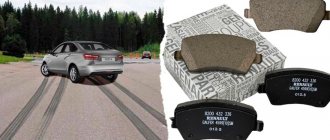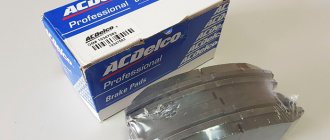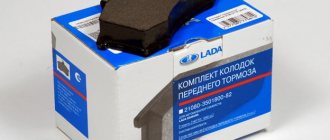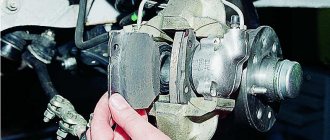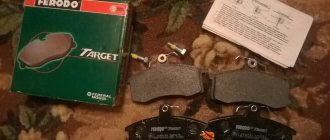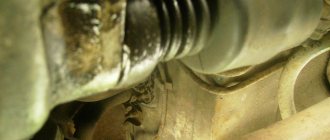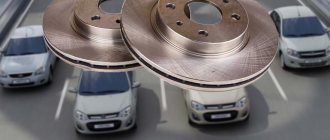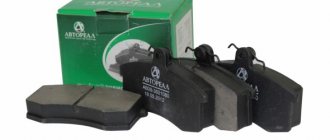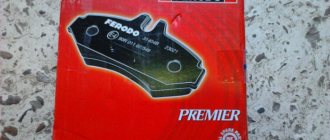The choice of brake pads for the VAZ 2107 is quite wide, starting from budget original options for 200-300 rubles. and ending with analogues from famous world brands with a price tag of under 1,500 rubles. per set. Therefore, it makes sense to take a closer look at the substitutes offered in online stores in order to select good brake pads for the VAZ 2107.
The front brake discs are equipped with pads with catalog number 2101-3501090. Their dimensions: length 83.9 mm, height 60.5 mm, thickness 15.5 mm. These pads are compatible with all models of the classic VAZ 2101-2107 family of cars. The supplier and manufacturer of original front brake pads for the VAZ conveyor is OJSC “TIIR 3.6”.
Rear pads 2101-3502090
The rear drum-type pads have part number 2101-3502090. Size: 250 mm in diameter and 51 mm wide. Original rear pads are produced at AvtoVAZ OJSC. These pads are also suitable for VAZ 2101-2107 and for Chevrolet/NIVA 2121 cars. Rear drum pad linings with article number 2101-3502105 are also available for sale. Many car enthusiasts replace the linings themselves, but this procedure requires certain skills. Replacing the pads is much easier and anyone can do it.
Where are the rear brake pads located?
If the car is fully equipped, that is, all the wheels will be in place, etc. You will practically not be able to see the rear pads, since they are located under the drum itself, or to be more precise, inside it, so in order for you to more or less be able to see the pads, then you will need to first remove one of the rear wheels and then remove the ram itself and only then will you see the brake pads in front of you.
When do you need to change rear brake pads?
They need to be changed if the thickness of the lining (the lining is present on the pad itself and only it brakes the car) has become less than 1.5 mm, but to understand what the thickness has become, you will, of course, need to remove the drum and only then take a look on the thickness of the lining itself (The lining in the photo below, so that you can simply understand, is indicated by a red arrow, and the blue arrow indicates the block body).
Isn’t there any other way to understand when the pads have become unusable, you ask? So it is possible, namely, the first signs of wear on the pads will be a squeaking sound when you press the brake pedal, which will come from the rear; over time, this squeaking sound can develop into a stronger sound and, ultimately, if you don’t pay any attention to this, it may a strong grinding sound of metal on metal will begin, this will tell you that most likely the pads are to blame.
Note! If you have a similar situation, but only a grinding noise comes from the front part when braking, then this will indicate that your front brake pads need to be replaced. For information on how to replace them, read the article entitled: “Replacing front pads"!
And what’s more, if when you remove the old pads from the car, or take new ones out of the box, then be sure to inspect them and if you find oil on the brake pad itself, if the pad itself moves away from the body, and also if If you find chips and various kinds of cracks in this same lining, then this pad needs to be replaced and its further use does not make any sense.
Brake pad problems
The parts of the braking system in question have to be changed not only when they wear out, but also when malfunctions occur that are associated with the use of low-quality consumables or too active driving. The following characteristic signs indicate problems with the pads:
- creaking, grinding and other extraneous sounds when braking;
- car skidding when pressing the brake pedal;
- to operate the pedal you have to exert more or less force than usual;
- beating of the pedal when braking;
- after releasing the pedal, it does not return to its original position;
- the presence of black dust on the rims.
Extraneous sounds
Modern brake pads are equipped with special indicators that indicate wear of these car parts. The indicator is a metal strip that is attached below the friction lining. When most of the material is worn out, but the pad is still able to decelerate, a characteristic grinding or whistling sound appears when the brake pedal is applied. If the pads are not equipped with such indicators, the presence of extraneous sounds indicates obvious wear of the elements in the brake mechanism and the need to replace them.
Pad wear can manifest itself in different ways, and one of the signs is extraneous sounds when braking.
Skid
If the car skids to one side when braking, then the likely cause is wear on one of the pads. The car can skid until it turns around, even on a dry surface. In addition to the pads, skidding can occur due to scuffing or deformation of the brake discs.
Video: why the car pulls to the side when braking
Some time ago I was faced with a situation where the car began to pull to the side when braking. It didn't take long to find the reason for this behavior. After a quick inspection of the car's underside, it was discovered that one of the rear brake wheel cylinders was leaking. This caused brake fluid to get on the working surface of the pad and drum, as a result of which the mechanism was unable to perform its function. The problem was resolved by replacing the cylinder and bleeding the brakes. If you encounter a similar situation, I recommend replacing the entire cylinder rather than installing a repair kit, since the quality of rubber products today leaves much to be desired.
Increase or decrease pedal effort
If the pedal has to be pressed unusually hard or lightly, the problem may be caused by worn or dirty pads. If everything is in order with them, then you should check the integrity of the entire brake system for fluid leaks.
Vibration
If there is vibration when you press the brake pedal, then a possible reason is that dirt has gotten between the brake disc and the pads, or a crack or chips have appeared on the latter. As a result, parts are subject to premature wear. However, you should be aware that a similar phenomenon is also possible due to problems with the hub or hydraulic cylinders of the brake system.
The pedal goes down
Sometimes it happens that the brake pedal does not move back after being pressed. This indicates that the pads are “stuck” to the disc. This phenomenon can be observed at sub-zero temperatures when moisture gets on the pads. In addition, air may enter the braking system, which requires inspection and subsequent repair or bleeding of the brakes.
Plaque on discs
Plaque on wheel rims is black dust, which indicates wear on the pads. If the dust contains metal particles, then not only the pads are erased, but also the brake disc itself. If such a situation arises, you should not delay inspecting the brake mechanism, as well as replacing failed parts.
The appearance of black deposits on wheels can be caused by active driving or natural wear of the pads.
One day I noticed that the front wheel rims were covered with black dust, and it was not road dust. It is no longer known what brake pads were installed at that time, but after replacing them with factory ones from AvtoVAZ, the situation remained unchanged. Therefore, I came to the conclusion that the appearance of black dust is a normal phenomenon, indicating natural wear of the pads.
Cost of brake pads for VAZ 2107
The price of high-quality pads for a classic VAZ, of course, depends on the lining materials used, technological features and manufacturer.
| Front pads for VAZ 2107 | |||||
| Brand | TIIR (original) | Allied Nippon 3.7 | ATE 4.0 | Ferodo 3.8 | Finwhale 3.5 |
| vendor code | 2101-3501090 | ADB 0281 | 13.0460-2966.2 | FDB 96 | V 211 |
| Price | 260 rub. | 340 rub. | 700 rub. | 430 rub. | 370 rub. |
| Rear pads for VAZ 2107 | |||
| Brand | VAZ (original) | TSN 2.8 | ATE |
| vendor code | 2101-3502090 | TSN 2.3.1 | 03.0137-0232.2 |
| Price | 750 rub. | 500 rub. | 1240 rub. |
It should also be emphasized that there are now a lot of fake brake pads for such a popular car. Therefore, choose only trusted manufacturers and pay attention to the packaging, configuration and labeling on the products. For example, the Ferodo brand uses tape with red or blue stripes to seal a box of pads.
What are the best pads to buy for the “seven”
And so, it is clear that you should not skimp on the reliability of the brakes, especially for a car designed in the middle of the last century and devoid of ABS and other bells and whistles to increase safety.
Therefore, we recommend buying pads for the VAZ 2107 that best meet the following indicators:
- optimal friction coefficient both in “cold” mode and on warm brakes (0.35-0.45 according to GOST);
- high lining life and minimal wear of the brake disc.
- absence of uncomfortable sounds, creaks, vibrations when braking;
The last point is subjective, since the pads squeak due to the unsatisfactory condition of the brake system as a whole, disc wear, and poor caliper performance, which is also very important to consider when replacing brake pads on a VAZ 2107 yourself.
Under severe operating conditions (under heavy loads and sudden braking), choose solid pads from the following companies: ATE, Ferodo. For more moderate city driving, which does not involve frequent overheating and large constant loads on the brake system, buy “softer” pads - Allied Nippon, Finwhale, TIIR.
When purchasing, it is important to pay attention to the composition of the friction clutch; pads using large metal shavings, in the form of inclusions, can greatly wear out the disc, leaving grooves on it. It is best to buy pads with modern high-tech compounds that will protect the disc from premature wear.
How to choose spare parts
How long the pads will last depends on the driver’s driving style (aggressive driving) and the conditions under which the car has to be driven. The pads wear out faster if the car moves around the city in jerks: either picking up speed in fairly short sections, or using sharp braking.
Helpful advice: When choosing spare parts, it is not enough to be guided by cost or brand. When purchasing new brake pads, buy them from the same batch. The features of friction lining production are important. If the spare parts are from the same batch and from the same manufacturer, the difference in the physical and mechanical properties of the material will be insignificant.
The procedure for replacing brake pads is carried out on both wheels of the same axle at once. Wherein:
- Be sure to analyze the condition of the parts and mechanisms of the brake system.
- To assess brake disc wear, use a caliper and measure its thickness.
- Check the entire assembly for damage and find out if the geometry of the structure is broken.
When and how to change pads on a VAZ 2107
It is better to think about replacing brake pads not when the linings have already worn down to 1.5 mm, and the brake disc has developed to a minimum thickness of 9 mm, but to decide on the choice in advance.
On average, pads last 15-30 thousand. km. depending on driving style. The service life of the brake discs is enough for 2-3 sets of pads.
In order to independently replace the pads with new ones, this should be done for both front wheels at once, that is, as a set. To replace you will need:
- jack;
- wheel wrench for removing wheels;
- pliers;
- screwdriver.
After lifting the body with a jack, you need to secure the rear wheels and the body well with supports to safely remove the front wheel. Next, remove the wheel and check the condition of the brake system, measure the thickness of the disc in different places, and the thickness of the linings.
In order to remove the old pads, you must first pull out the cotter pins that secure the pins in the hub. Next, carefully knock the pins out of the hub with a small screwdriver; you can use WD-40 if they are stuck to the caliper lugs. After these manipulations, remove the springs that secure the pads, move the pistons apart and remove the old pads. More details about replacing the front and rear brake pads on a VAZ 2107 can be found in the video or in the article with step-by-step illustrations on our website!
Front brake device for VAZ 2107
1 — fitting for bleeding the front brake drive; 2 — connecting tube of working cylinders; 3 — brake pad wear indicator wire; 4 — wheel cylinder piston; 5 — wheel cylinder clamp; 6 — brake pad lining; 7 - sealing ring; 8 — dust cap; 9 — pins for securing the pads; 10 — bolt securing the caliper to the bracket; 11 — steering knuckle; 12 — caliper mounting bracket; 13 — caliper; 14 — protective casing; 15 — cotter pin; 16 — pad pressure spring; 17 — brake pads; 18 — wheel cylinder; 19 — brake disc.
- Having disconnected the wires of the 3 front pad wear indicators from the plug connections of the wires, remove the cotter pins 15, and then the pins 9 with the springs, remove the springs 16 and the brake pads 17. Mark the pads so that during reassembly you can install them in their original places.
- Having straightened the locking plates, unscrew the two bolts 10 that secure the caliper to the bracket, and remove the caliper.
NOTE! It is possible to remove the front brake (without brake disc) complete with brake pads. In this case, it is enough to disconnect the plug connections of the brake pad wear indicator wires, disconnect the caliper hose and unscrew the caliper mounting bolts 10.
Article number and cost of good front brake pads for VAZ 2107 from third-party manufacturers
When choosing which pads to put on the front axle of a VAZ 2107, the car owner should take the most responsible approach to the selection of consumables. They will bear the main force when stopping the car.
Original products produced by TIIR have mediocre quality and satisfactory performance characteristics, so there is an opinion among owners that it is better to supply an analogue. Recommended brake pads are shown in the table below.
Table - Good analogues of the original front pads
| Manufacturer | vendor code | Approximate cost, ruble |
| Ferodo | FDB96 | 560-670 |
| Road House | 208000 | 510-650 |
| TRW | GDB140 | 900-1100 |
| Delphi | LP92S | 240-300 |
| Shafer | SB20166 | 200-280 |
Article number and cost of good analogues of original rear brake pads for VAZ 2107
Braking a VAZ 2107 is accompanied by a slight force on the rear brakes. Therefore, braking performance does not depend much on the drum pads. More important during operation are the noiselessness and wear resistance of consumables. All products listed in the table below have these qualities.
Table - Recommended analogues
| Pad manufacturer | vendor code | Approximate price, ruble |
| Bosch | 986487893 | 930-1050 |
| TRW | GS8222 | 1600-2000 |
| ATE | 3013702322 | 1200-1500 |
| Ferodo | FSB59 | 1000-1300 |
| ABS | 8007 | 880-1200 |
Replacing front pads on a VAZ 2107
Replacing the front disc pads of a VAZ 2107 is carried out according to the instructions given below.
- Jack up the car.
- Remove the wheel.
- Treat the brake mechanism with penetrating lubricant.
- Clean the cotter pins from dirt.
- Using pliers or a thin screwdriver, remove the pair of cotter pins holding the pad rods.
- Using a screwdriver, press out the pad rods. If they do not come out, then the assembly must be generously watered with a penetrating lubricant, for example, WD-40. Light tapping on the screwdriver is allowed to make it easier to squeeze out the rods. In this case, their complete dismantling is not required, since it will only be enough to release the pads.
- Remove the spring clips that are used to hold the brake pads and prevent them from rattling.
- Move the pads from their seat. Worn consumables usually slip out easily. If jammed, it is recommended to pry them off with a screwdriver. As a last resort, a penetrating lubricant should be used.
- Remove the pads.
- Inspect the brake cylinder boots. If there are signs of rubber aging or damage, the seals should be replaced.
- Check the brake fluid level in the reservoir. Pump out the slurry to the middle position.
- Press both pistons as far as possible using a spacer and a lever, which can be used as a crowbar, pry bar, or spatula. If they are not separated, then inserting a new block will be very difficult.
- Install the pads in their seat.
- Reassemble everything in the reverse order of removal.
- Check the operation of the brake system.
Removing the brake caliper
To remove the caliper you must do the following:
- lift the car on a lift or jack up the wheel on which the brake caliper needs to be removed;
- Using a wrench, remove the bolt securing the brake hose bracket;
- remove the bracket so that it does not interfere with further actions;
Important: under the bracket fastening bolt there is a spring washer, which must not be lost when dismantling the bolt and bracket.
- unscrew the bolt securing the brake hose;
- remove the bolt after first removing the two o-rings;
- insert a rubber tube or bolt of a suitable diameter into the hole in the brake hose tip to prevent brake fluid from leaking out;
- Use pliers to remove the cotter pins securing the brake pad pins;
- pull out the pins securing the brake pads and remove them using a bit or a thin, but not sharp, screwdriver;
- remove the retaining springs from the brake pads;
- remove the brake pads;
Advice: if you plan to use the brake pads in the future, they should be marked with a marker so that during reassembly they can be installed in the same place where they were. If this is not done, they will wear out faster and brake worse.
- bend the locking plates of the washers on the caliper mounting bolts;
- unscrew and remove the bolts securing the caliper to the steering knuckle;
- Remove the brake mechanism (caliper) of the VAZ 2107 from the brake disc.
Important: the upper and lower caliper mounting bolts differ in the shape of the head. When installing the unit in place, it is necessary not to mix them up.
How the repair is carried out
If the mechanism is damaged or there are deformations, it must be completely replaced. Repairing a VAZ 2107 caliper involves replacing non-working cylinders. The repair procedure is as follows:
- The device is fixed in the jaws of a vice.
- Unscrew the fastenings of the connecting metal tube. After this, the tube must be removed.
- Knock out the working cylinders from the guides.
- If there are none, remove the clamps and replace them with new cylinders.
- Place the cylinders in the guides, and then install the connecting tube, followed by tightening the fittings.
- If it is necessary to repair the brake cylinders on the caliper, then the essence of the repair actions is to change the rubber seals.
- To make repairs, you will need to remove the cylinder and then remove the rubber cap from the cylinder using a screwdriver.
- Press the piston out, then remove the sealing ring using a screwdriver.
- In place of the old ring you need to install a new one from the repair kit. The cylinder, as well as the piston and ring, must be lubricated with brake fluid.
- Install the piston into the mechanism cylinder.
Read, it may come in handy: How to independently restore the effectiveness of the handbrake
Step-by-step replacement of rear pads on a VAZ 2107
You can replace the rear drum pads using the algorithm below.
- Raise the rear of the car using a jack and remove the wheel.
- Remove the drum.
- Disconnect the lower spring. To do this, you need to pry it off with a screwdriver.
- Using pliers, rotate the cotter pins until they align with the slots located on the washer.
- Turn the cotter pin on the other side as well.
- Straighten and remove the cotter pin that secures the handbrake lever.
- Remove the upper spring using a screwdriver.
- The above actions will cause the pads to fall down. After this, you need to disconnect the lever from them.
- Inspect the springs. If necessary, purchase a repair kit for the VAZ 2107 drum brake and replace the failed elements.
- Reassemble everything in the reverse order of removal.
The safety of the VAZ 2107 car depends on the braking system. Therefore, if any difficulties or questions arise when replacing the pads, it is recommended to watch the corresponding thematic video. This will help you avoid maintenance errors.
Installing the brake mechanism and bleeding the system
The restored caliper of a VAZ 2107 car is put on the disc and secured with bolts to the steering knuckle. The pads are inserted into the gap and fixed with guide springs; if necessary, parts are replaced with new ones. The brake hose and tube are installed in place, and the system is filled with fluid to the specified level. Repair of the brake mechanism ends with bleeding to remove it from the system.
This process on a VAZ 2107 car is carried out as follows: a hose of a suitable diameter is put on the nipple of the working cylinder. Its other end is lowered into a container with liquid. The assistant sits behind the wheel and presses the brake pedal several times and holds it in that position. Using the key, release the nipple and let out the air. We repeat this action until bubbles stop appearing in the container.

